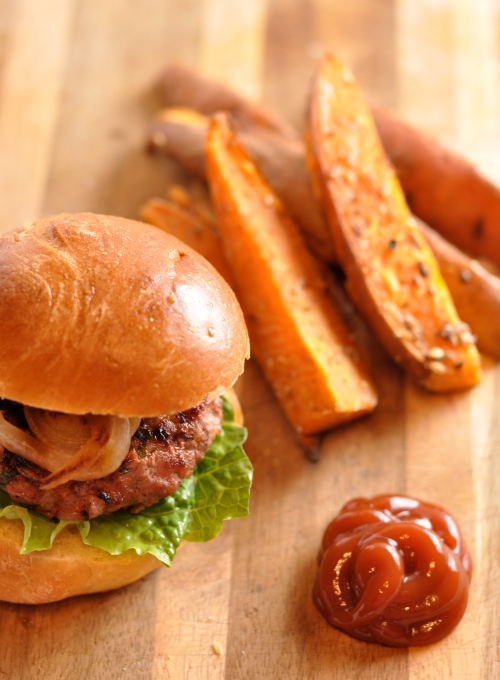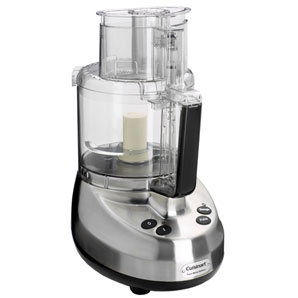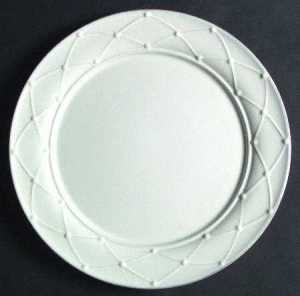Hey folks…it’s bread week here at Blue Jean Gourmet! I’m lucky enough to know the beautiful & talented Jessie Fila, a friend from high school who now works as a pastry chef at The Schoolhouse at Cannondale in Wilton, Connecticut (full bio at the end of this post). She generously agreed to guest blog for me, sharing her bread expertise & recipes. Today she brings us ciabatta–which, wow, I’m still dreaming about–and later in the week, challah!
I don’t know about ya’ll, but baking bread has always intimidated me, so I decided Jessie’s guest posts would be the perfect opportunity for me to learn. I tested each of the recipes that Jessie sent, and let me just tell you–there was a lot of gratuitous moaning over fresh bread in my house each time. Are these recipes simple? No. They do require time and attention. But the thing is, they aren’t rocket science, either. Just make sure you aren’t in a rush and enjoy the process, it’s very gratifying. Big thanks to Jessie for being our bread evangelist!
—
I love bread. I love everything about bread. And I don’t think I’m the only one, considering the idiom, “the best thing since sliced bread,” is one of the most popular comparative phrases out there. Truly, bread is by far and away one of my favorite things in the world. I could never get into the no-carb or low-carb diets because then I couldn’t eat bread! And who doesn’t want to eat bread?
As much as I love to eat bread, I like to make bread from scratch by hand even more. There’s something therapeutic, meditative, and sometimes hypnotic about kneading dough that helps me focus and reflect just as effectively as any good yoga class. It’s also great exercise, building upper body strength, as well as working the core muscles. Indeed, making bread is one of my more favored pastimes. There’s nothing more rewarding than slicing into a freshly baked, warm loaf of bread, knowing you crafted it by hand. True, it is a labor of love, but it is well worth the effort.

The key to making delicious bread is understanding the ingredients and the process. For most basic sandwich or rustic breads, such as white bread, a baguette, or ciabatta, the ingredients are simple: flour, water, yeast, and salt. Other breads, called egg breads, like challah or brioche, call for eggs, butter, sugar, and milk in addition to the basic ingredients to help enrich the dough and make it less chewy, more dense, and flavorful. There are, of course, many other types of breads, but for this week I’m going to stick to these two main types.
Most ingredients are straightforward in their purpose. Flour is used to give the bread structure and stability. When mixed with water, the proteins gelatinize; vigorous agitation and stretching help to develop these proteins into gluten. This agitation and stretching is exactly what you’re doing when you knead dough. In developing the gluten, you’re creating the unique dense and chewy structure of bread. Most bread bakers use bread flour instead of all-purpose flour because it has a higher protein content and will therefore create more gluten, resulting in chewier bread. Salt is used mostly for its definitive ability to flavor foods without adding its own flavor component. Salt is unique in the food world in that it doesn’t have a distinct flavor, yet it manages to enhance the flavors of everything in the dish it is added to. This is why even cookie and dessert recipes will call for a small amount of salt added to the dough or batter.
Yeast is the one ingredient in my list that can be most difficult to work with. It comes in many forms these days, the most well-known being active dry. Yeast is a fungi, and is therefore a living organism. It is easily killed and is very finicky. It likes two main things: to exist in warm, wet environments and to eat. The water we use in bread is warm, between 105 and 115° F. If it is any hotter or colder, the fungi will not be able to survive and the bread will not rise. This brings us to what yeast likes to eat: the natural sugars found in flour. When the yeast eats the sugars, it processes the food like any other living organism. The yeast extracts what it needs from the sugars to survive and expels the rest as waste. Yeast’s form of waste is carbon dioxide. When the yeast gives off the gas, the CO2 gets trapped in the gelatinous structure the flour and water have created, otherwise known as gluten, pushing the dough upward, causing it to rise. This is the reason we let the bread rise a couple of times before baking, to allow the yeast to do its thing and give off the gas that contributes a strong amount of flavoring to the bread.
The process for making bread is not as simple as making a cookie dough or a cake batter and is far more time-consuming. To start off, the yeast must be activated, allowing it to give off the much-coveted CO2 gas, and once all of the flour has been added, the dough must be kneaded. The kneading process is very rhythmic and is easy once you get the hang of it. Once you have your dough with all of the flour incorporated, turn it out onto a well-floured work surface, such as a counter. Shape it gently into a disk. Grasp the dough with both hands at the top and fold the dough into the center of the dough. Press down on the dough as if you were trying to fuse the top and bottom parts together. While pressing, use the heels of your palms to push the dough down and away from you. Give the dough a quarter turn clockwise and repeat the process until the dough is smooth.
Once you’ve kneaded the dough, it needs to rest and to rise. The rising process can be repeated at least two times before the dough is shaped and baked. After all the time and hard work, though, what we’re left with is a delicious creation is delectable on its own or with a small swipe of butter, but also serves as a key ingredient in many other dishes. So, for each bread recipe, I’ve also included a few ideas for how you can use the leftovers (if there are any!)

CIABATTA
Recipe from Williams-Sonoma Bread
All bread takes time and effort to make, but ciabatta requires a little extra love and effort. This recipe makes use of a starter, which is used to feed the yeast and serves to add more flavor to the finished product (sourdough is another bread that calls for a starter).
When timing the ciabatta, be prepared to make the starter at least 8-12 hours ahead of time so it has enough time to “proof” or ferment.
ingredients:
for the starter:
1 1/3 cups water, at room temperature
2 1/3 cups unbleached all-purpose flour
¾ teaspoon active dry yeast
In the bowl of stand-mixer fitted with a paddle attachment, combine the water, 1 cup of the all-purpose flour, and the yeast. Mix on low speed for 1 minute. Add the remaining flour and mix until smooth and soft, 1 minute more. Cover the bowl with plastic wrap and let sit at room temperature until almost tripled in bulk, 4-6 hours. It will smell yeasty. Refrigerate for 8-12 hours or for up to 3 days.
for the bread:
3 T warm water (105°F – 115°F)
¾ cup warm milk (same temp as the water)
2 tsp. active dry yeast
2-2 1/3 cups bread flour, plus extra as needed
1 ½ tsp salt
2 T olive oil, plus extra for greasing
When ready to make the dough, remove the starter from the refrigerator and let it stand for 1-2 hours. To make the dough, fit the mixer again with the paddle attachment. Add the warm water and milk and the yeast to the starter and mix on low speed. The mixture will be soupy.
Add 1 ½ cups of the bread flour, the salt, and the oil. Mix on low speed until smooth, about 3 minutes. Add only as much of the remaining bread flour as needed to form a very soft and moist dough, and mix on low speed for about 5 minutes, occasionally scraping the dough off the sides of the bowl and the paddle. The dough should be very soft and sticky, pulling away from the sides, but still sticking to the bottom.
Cover the bowl with the oiled plastic wrap and allow to rise at room temperature until doubled or tripled in bulk, about 2 hours. Line a baking sheet with aluminum foil and sprinkle generously with bread flour. Turn the dough out onto a lightly floured work surface (it will deflate), sprinkle lightly with flour, and pat with your fingers into a 14 by 5 inch rectangle. Fold the rectangle like a letter, overlapping the 2 short sides in the middle to make 3 layers.
Cut crosswise into 2 equal rectangles and place each half on the prepared sheet pan. Cover loosely with plastic and let rest for 20 minutes. Remove the plastic and sprinkle generously with flour. Splay your fingers apart and press, push, and stretch each rectangle to make it irregular and about 11 inches long and about the width of your hand. You want the dimples in the top; this is traditional. Cover again loosely with plastic and let rest until tripled in bulk, about 1 ½ hours. Repeat the dimpling process again 2 more times during this rise.
Preheat the oven to 425°F. Sprinkle the tops of the loaves with flour. Bake until deep golden brown, 20-25 minutes. Let cool on the baking sheet. Serve warm with olive oil for dipping. Yields two large loaves.

What to do with leftover ciabatta, besides just eating it? Here are two ideas:
TUSCAN BREAD SALAD
ingredients:
½ a loaf of day-old ciabatta, cubed
2 or 3 ripe medium-sized tomatoes, chopped
1 ball of fresh mozzarella, cubed
Generous handful of fresh basil, chopped
½ cup of extra virgin olive oil
¼ cup balsamic vinegar
Salt and pepper to taste
Combine all ingredients in a bowl and toss to combine.This is my favorite combination for this salad, but you can increase or decrease any and all of the ingredients to suit your fancy.
You can also try this with any veggies and any Italian cured meats, such as Proscuitto, . Any oil and vinegar combination works well with this recipe, too, and it is also excellent with citrus juice.
ITALIAN BREAD SOUP (RIBOLLITA)
ingredients:
2 T extra virgin olive oil, plus more for drizzling
1 medium-sized onion, chopped
2 carrots, chopped
2 ribs of celery, chopped
1 bay leaf
2 large garlic cloves, finely minced
Salt and pepper to taste
1 can great northern white beans, drained (small cannellini beans work, too)
1-8 ounce can of tomato sauce
3-4 cups of chicken or vegetable stock
½ a loaf of day old ciabatta
1 bag baby spinach
Parmesan cheese
In a heavy bottomed saucepot, heat the olive oil over medium heat. Add the onions, carrots, celery, and bay leaf and sauté until the veggies are softened and the onions are translucent, about 5-7 minutes. Add the garlic. Cook the garlic for about 30 seconds to 1 minute, or until the sharp aroma has subsided. Season with salt and pepper.
Add the white beans, the tomato sauce, and the desired amount of stock. I would start with the lesser amount; more can be added later if the finished product is too thick. Allow to come to a gentle simmer. Once the stock is bubbling, tear off the ciabatta, crust and all, into big chunks and submerge into the stock. Once all of the bread is in the liquid, break it down and mash it around with a wooden spoon. If the soup is too thick for your liking, add more stock. I like mine stew-like and so thick a spoon can almost stand upright in it.
Once the desired consistency has been achieved, add the spinach in batches, allowing to wilt in between additions. Turn off the heat, remove the bay leaf, and serve. Sprinkle with grated Parmesan cheese and drizzle with the olive oil.
 Jessie Fila fell in love with baking the summer after high school graduation when boredom led to a discovery that she is very good at pastry! After attending college in Florida, she traveled to New York to complete her Associates Degree in Baking and Pastry Arts from The Culinary Institute of America. She loves dessert because it’s often the most memorable part of any meal, and can easily make or break a diner’s experience. At home on days off, she cooks to relax and to feed her lucky husband Ken.
Jessie Fila fell in love with baking the summer after high school graduation when boredom led to a discovery that she is very good at pastry! After attending college in Florida, she traveled to New York to complete her Associates Degree in Baking and Pastry Arts from The Culinary Institute of America. She loves dessert because it’s often the most memorable part of any meal, and can easily make or break a diner’s experience. At home on days off, she cooks to relax and to feed her lucky husband Ken.
 //
//

























